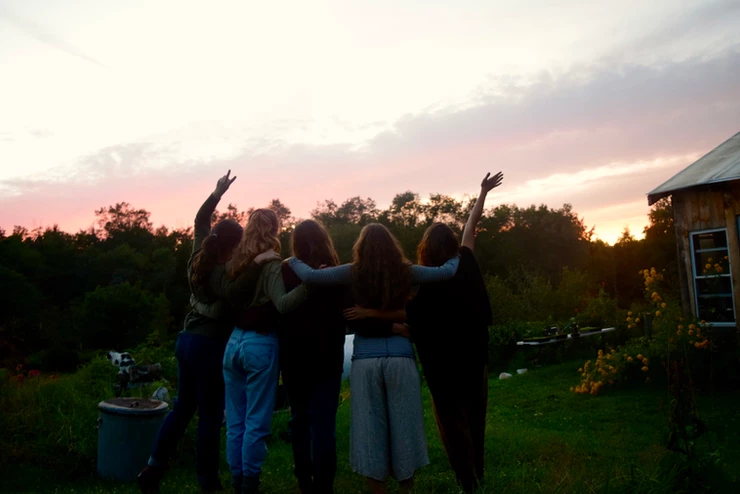In the summer of 2021, I had the transformational opportunity to live and work on a small off-grid farm in rural upstate New York.
I’ve always loved being in nature, and I’ve always been fascinated by the different relationships that we as humans have with nature, or what’s often called “natural resources”.
I’m still that nerdy kid who asks annoying questions like:
- Where does the food come from (before the grocery store)?
- Where does the water come from (before it comes out of the tap)?
- Where does the electricity come from (before it turns on the lights)?
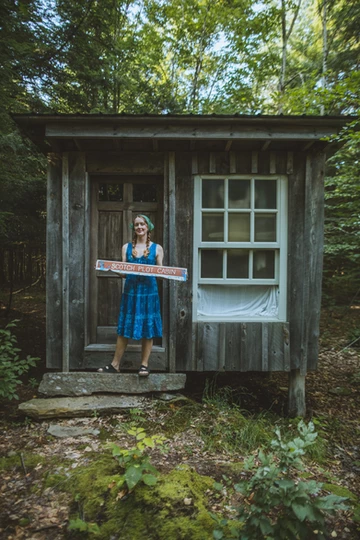
For most of my life, I’ve been privileged to not have to think about these things — to get to think about them, if I want to. But countless communities around the world do not have access to healthy food, clean water, or safe energy. In these communities, the more immediate questions are:
- How am I going to feed my family on a poverty wage?
- How am I going to bathe my kids when the pipes are contaminated with lead?
- How are we going to resist yet another industrial waste facility moving into our neighborhood and poisoning the air we breathe?
We know injustices like these continue to happen because our dominant economic system prioritizes short-term profits above all else, even if it means exploiting people and destroying our planet. But, let us never forget: it doesn’t have to be this way. Another world is possible. Another world is possible. I’ve always held that truth in my heart. On the farm, I got a powerful glimpse of another possible world, where humans care for each other, and nature, as much as nature cares for us all.
Just to be clear: I am not saying everyone should “go back to the land” and give up all modern conveniences and merely subsist. That’s unrealistic for many reasons, but more importantly, a successful back-to-the-land movement would mean almost nothing without a successful Land Back movement. As the land’s original stewards, Indigenous peoples hold the knowledge and life-ways that keep humanity in tune and in balance with the rest of nature. If we want a future that is sustainable and just, we need to listen to Indigenous leaders, activists, educators, farmers, etc., and give them the resources to do what they do best.
…a successful back-to-the-land movement would mean almost nothing without a successful Land Back movement.
Living off-grid and working on a farm gave me such an intimate appreciation of how connected we all are to the land, even if most of us don’t see it every day. For the first time in my life, I was in close contact and direct relationship with where all my bare necessities come from.
We got our food from the farms’ plants and animals, which we all helped take care of. (We supplemented whatever we couldn’t grow or raise ourselves with products from local farmers’ markets.)
We got our water from the rain, collecting it into rain barrels we set up, and also from the natural underground spring in the forest by the farm.
We got our electricity from the sun. There are solar panels on the roof of the farmhouse, and we had solar-powered lanterns we’d leave outside to charge in the sun all day, to use at night in our cabins in the woods.
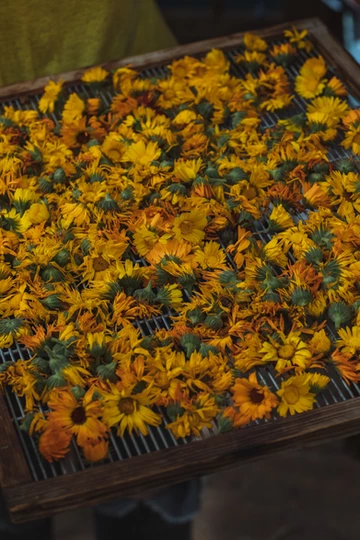
For medicine, we mostly used plants and herbs; many of them grow wild around the farm. One of my favorites was St. John’s Wort (before I never knew its name). On my first night, I was nursing a painful sunburn, and when I mentioned it was itching and peeling, I was given a jar of oil that had been infused with St. John’s Wort flowers. These flowers have strong anti-inflammatory properties, but I wasn’t expecting it to work so quickly.
I put the oil on my burn a few times, and by the next day, I could already notice and feel how much my skin had started to heal. A few weeks later, right before a big rain, we harvested dozens of handfuls of St. John’s Wort flowers, along with calendula flowers and comfrey leaves, and infused them all in big mason jars of olive oil. About a month later, we carefully strained out the plant matter, combined the infused oil with melted raw beeswax, and made a heal-all salve!
The food we ate was according to the season, and it changed over the course of the summer. In June, we were eating huge salads of romaine, butter lettuce, Batavia, and purslane, and we scrubbed and roasted potatoes by the bucketloads to finish off the storage supply from the previous year’s harvest. In July, there were so many wild blueberries we could hardly pick them all, and we made blueberry coffee cakes, blueberry pies, blueberry scones, and more. In August, we were eating big stir-fries of zucchini, cauliflower, broccoli, peas, and tomatoes, and starting to harvest the early apple varieties, which we made into applesauce, apple pies, and apple spice turnovers.
The farm also has about fifty chickens, all of the same breed, which are raised for their meat. At the start of summer, when I first arrived, they were little baby chicks; only two and a half months later, they were almost full-grown and ready for slaughter. They live their short lives roaming free in a large enclosure, foraging for insects, with a chicken tractor (coop on wheels) so that they can always get fresh grub. And their supplemental feed was organic cracked corn from a nearby independent farm. Needless to say, these birds live a really good, healthy life, especially compared to most commercial or industrial chicken operations.
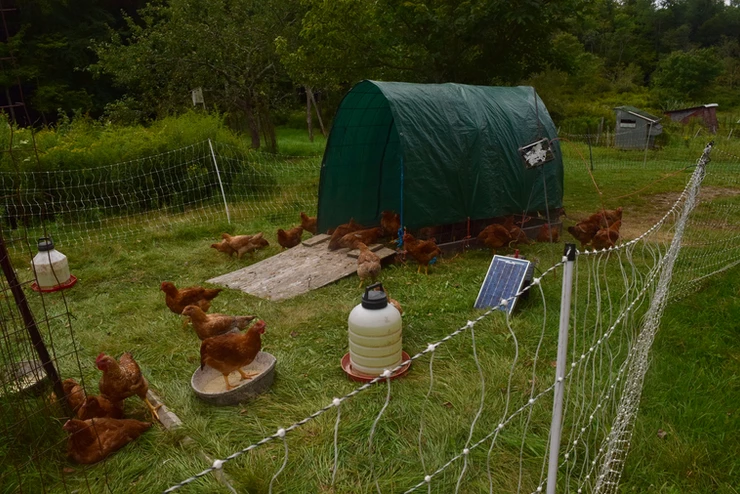
One day, about a week before leaving the farm, it was time to slaughter and butcher a few of the chickens who had grown to be the biggest. But before going into their coop, I took some time to sit with the sheep. I felt the need to reflect on what I was about to do. This would be my first time ever killing an animal. As soon as I went into the sheep’s pasture, two of the friendliest lambs came over to me and nuzzled up into my arms. I gazed into their sweet, innocent, chocolate-colored eyes, and stroked their soft faces, and I realized: I could never kill a lamb… But I wasn’t sure I felt the same way about chickens. Why is that?
Maybe part of the answer is that I don’t eat lamb, and I do eat chicken. I’ve always felt that if you eat meat, you should be able to kill the animal(s) providing that meat. Chicken has been my main meat source for my entire life, and I was ready to stop eating it if I couldn’t bring myself to kill it. I knew that taking an innocent being’s life would be an extremely difficult thing for me to do, but I also knew how rare this opportunity is— to truly connect with where my food comes from. Very few people have that opportunity. So I did it. I was sobbing pretty much the whole time, but I did it.
First, we took them over to a secluded area by the edge of the forest, away from all the other animals, where we held a ceremony to give thanks for their lives. We made an offering of cedarwood, sage, and tobacco. While some of us choked back tears, everyone breathed in the sacred interconnectedness: just as we nourished these chickens, they would nourish us. Then, we went over how to handle the bird (gently but firmly, with its wings tucked in), and practiced swinging the axe— in one swift action. We did it in pairs: one person held the bird down on the chopping block while the other quickly beheaded it.
Once the chicken was beheaded, we placed its body in a large bucket to bleed out, and then dunked each one in its own smaller bucket of boiling hot water, to help loosen the feathers. We plucked every last feather by hand (which was definitely the most time-consuming part of the process), and then placed the birds on a big table to learn how to carve them up for meat. Butchering came much more easily to me than slaughtering, and I never thought I would say this, but I actually really enjoyed it. Seeing and feeling the anatomy up close was so fascinating, and beautiful. I ended up butchering three whole chickens, and I would absolutely do it again.
A few hours later, I took the legs, thighs, breasts, and wings out of the ice chest and placed them on huge baking sheets; added olive oil, salt, pepper, and fresh rosemary from the garden; and put them in the bake oven to roast for an hour. That night, we feasted on the freshest, most nutritious chicken I’ve ever had. It was so fresh it almost tasted gamey— it tasted like it had smelled while I was butchering, which was off-putting at first, but in the end, I felt really nourished by all the protein and the micronutrients. I don’t think I’d ever felt so grateful for chicken as I did in that moment.
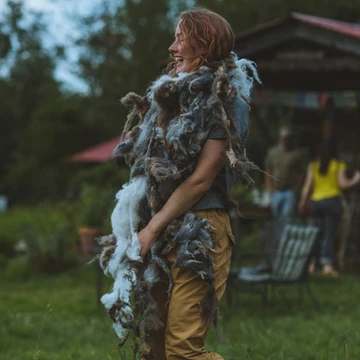
I also got to appreciate, firsthand, how much labor and time goes into fiber arts. About thirty sheep live on the farm, and most of them are raised for their wool. They get sheared in the spring, so by the time I got there in the summer, the sheep were fluffy again, and we had tons of gorgeous wool to sort through, all different textures and shades of brown, gray, white, and black. Some of it was matted, or stained with feces or urine, but we were able to pick out the good stuff, and then we washed it in buckets of boiling hot water, careful to not stir it around too much so that it wouldn’t felt.
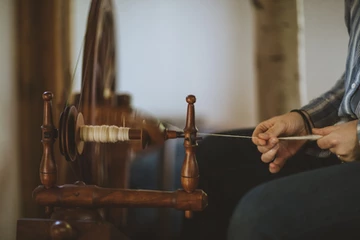
Once the washed wool was dry, we used brushes called “carders”, which have little metal spikes, to get all the hairs in the same direction. Then, we used a drop spindle and a spinning wheel to spin the carded wool into yarn. For dye, we harvested goldenrod flowers, boiled them, added alum as mordant, put the yarn in, and the yarn turned bright yellow! This fall, I’m going to use the yarns I made to knit my first-ever homemade beanie, to keep my head warm during my first winter in the Northeast.
But off-grid farm life, at least in my experience, wasn’t just about making your own stuff and growing your own food. It was also, and to a greater extent, about community. There were only seven of us, all relying on each other to do our parts to keep the farm running, and sometimes it was hard work. So the moments where we could relax and simply enjoy each other’s company were that much sweeter. Every Friday night, we’d have music night. We’d gather around a blazing bonfire under the twinkling stars, with someone on the guitar and someone on the fiddle, while the rest of us laughed trying to remember the lyrics to old folk songs, or making up our own verses as we went.
For some music nights, we’d have neighbors or friends from out of town and they’d bring their instruments or lead us in rounds. As we sang in rounds and the melodies and harmonies began to align, it felt like we were all one voice, one vibration, one being— pure magic. Friday nights on the farm were my favorite. To top it off, we’d have peppermint tea (brewed with leaves we harvested in the garden), a slice of apple or blueberry pie right out of the bake oven, and the best night’s sleep after a long week of work. It was one of the most satisfying feelings ever.
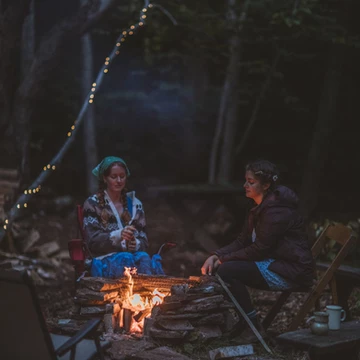
Being in community is also work. I knew this from previous co-living experiences (I lived in co-ops during and after college), but I came to the farm not knowing anyone there, and had to quickly adapt to living and working with totally new people, in a totally new environment, through a totally new lifestyle. It was a challenge, at times, to navigate the group dynamics, different communication styles, and the ever-shifting balance between self-care and collective care. I learned so much about myself through this experience; I came to deeply appreciate how important it is for me to be a part of a community that’s rooted in collaboration, support, accountability, learning, growth, and healing.
There was one day in particular that shifted my perspective a lot, and reinforced the importance of community for me. We had just gotten back to the farm from the local K-12 school, where we were volunteering to teach the kids more about plants, soil, gardening, and naturalist observation. The sky had been tinted orange all morning, and it was only getting worse. In fact, it had started the evening before, when we noticed the sun turning red as it was setting. I and two of the others in the farm crew are from California, so our minds immediately went to wildfires. But instead of listening to our intuition, we waved it off and reassured ourselves: “No way… We’re nowhere near anywhere that’s burning…”
The next day, after getting back from the school, I was starting to get a headache and sore throat, and we finally thought to check the air quality index. The AQI was 160— way higher than the average 10 or 20 you see in rural upstate New York. We should’ve been wearing N95 masks, indoors and out. Then, it hit me: the rainstorms we’d been having were part of larger weather systems, that brought the smoke from the Western wildfires over to us on the East Coast. Of course… The climate is global. The climate emergency is global. It’s happening everywhere; there’s no escape.
I knew this fact, but I didn’t feel the full weight of it, emotionally, until that day. I thought of the kids we’d just been with at the school. I thought about how they have to grow up in a world that’s becoming increasingly unhealthy and unsafe. They have to grow up in an era that is literally “code red for humanity”. In that moment, I was overwhelmed with grief and despair and anguish. I let the tears flow, and the rest of the group witnessed me and held me. It opened up an important conversation: “How do we adapt?”; “How do we build resilient communities?”; “How do we support each other through this?”
One of the ways we as humans can do all of that is by coming together to demand better from our institutions, and advocate for the brighter future we want to build. So, that’s what we did: the farm crew made the trip to a climate action in Newburgh, NY, where a fracked gas power plant was proposing expansion, in violation of the state’s new climate law. We showed up with local residents and folks from all over the Northeast to protest fracking and pollution, and emphasize a just transition to 100% clean, renewable energy. Nearly a hundred people of all ages and backgrounds paddled out onto the Hudson River in canoes and kayaks, singing and chanting for climate justice.
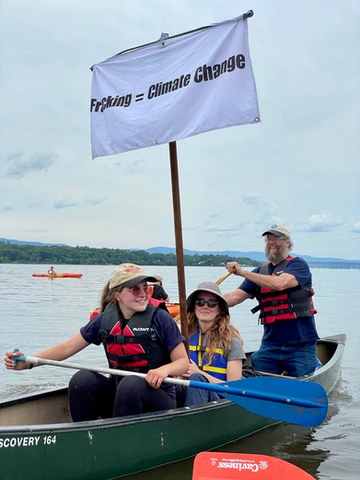
I’ll never forget the feeling of being out on the water that day; I felt the raw power of a community rising up for what’s right, and I was a part of it. And it made me reflect on how climate change is already happening; I was already seeing it. Our rapidly changing climate impacts every aspect of life, every sector of the economy, and farming is no exception. Some weeks, the farm crew would go visit and work on another small family farm nearby, to get a sense of their operation and hear about how they’re dealing with the challenges they face, which include impacts from climate change, as well as debt, labor shortages, regulatory hurdles, and other difficulties. I also learned more about farmworkers’ rights and the campaigns & resources in that fight.
These field trips gave me a more holistic understanding of the realities of farming, in practice and in context. Being a farmer has become one of the lowest-paid vocations, especially if your farm is not industrial-scale. Despite that, all the farmers we met emphasized the importance of paying their workers a living wage or salary, and providing good working conditions and good work culture. They also attested to the need, from a business perspective, to constantly adapt, get creative, play to their strengths, and find their niche. For some, that means going above & beyond to grow and market a popular food product, such as organic micro-greens; for others, it looks like hosting kids’ summer camps, or “farm stays” for city folks.
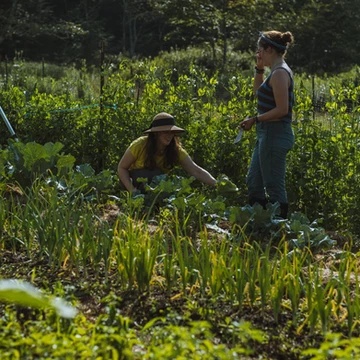
Every farm is different and unique, both in terms of ecological variables like soil type, water availability, microclimate, native species, etc., and in terms of what kind of work the farmer is willing and able to do, since some methods are more labor- or time-intensive than others. For example, “no-till” has become a popular way to protect and regenerate soil, and to sequester carbon, but it doesn’t necessarily work everywhere. When a farm’s soil is mostly clay, which gets water-saturated and compacted very easily, no-till might not be the most efficient or effective solution.
Before coming to the farm, I didn’t have many preconceived ideas about farming or off-grid living; my intention was to be open to whatever the experience had to teach me. I came without expectations, and I left with a heart full of gratitude, and a mind full of questions to ponder and ideas to share. It made me re-think what I truly need, and what brings my life meaning and joy.
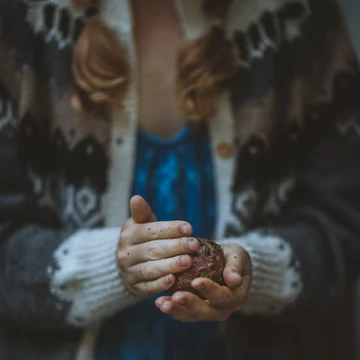
Overall, the experience was an affirmation of my values, beliefs, and hopes for humanity. For as long as I can remember, I’ve always been enamored with the fact that everything in nature is (and must be) interconnected and interdependent, and I finally got to actually be a part of that on the farm— from the water cycle to the nutrient cycle to the carbon cycle, from soil health to plant health to animal health… and from all of that & more to my own well-being.
Like most people in this day and age, I’ve been socialized to be a consumer, often with little choice in the matter. But on the farm, I was a producer. My role in the “web of relations”, as many Indigenous cultures call it, was a caregiver. A steward. And that’s the way it should be. Everyone has the capacity to cultivate this mutually beneficial relationship with nature, because for the vast majority of human history, that’s how we’ve survived. That’s how we’ve adapted and evolved and thrived.
Of course, now we are at a crossroads. “Whether it is to be Utopia or Oblivion will be a touch-and-go relay race right up to the final moment…” as Bucky Fuller put it. The revolutionary project of re-aligning humanity with the rest of nature, and with our best selves, can feel daunting, to say the least. We can empower each other by channeling anxiety into action, and by holding space for grief, as we give each other reasons for hope.
Personally, I’m drawn to urban farming and food sovereignty within cities— it frustrates me to no end that healthy food access is often a privilege when it should be a right. I will probably end up living on an off-grid farm again someday, but for now, I’ve decided to move to Brooklyn, NY, and plan to volunteer at local community gardens as a way to get started. I’m so grateful for my experience on the farm that led me to embark on this new chapter of life.
